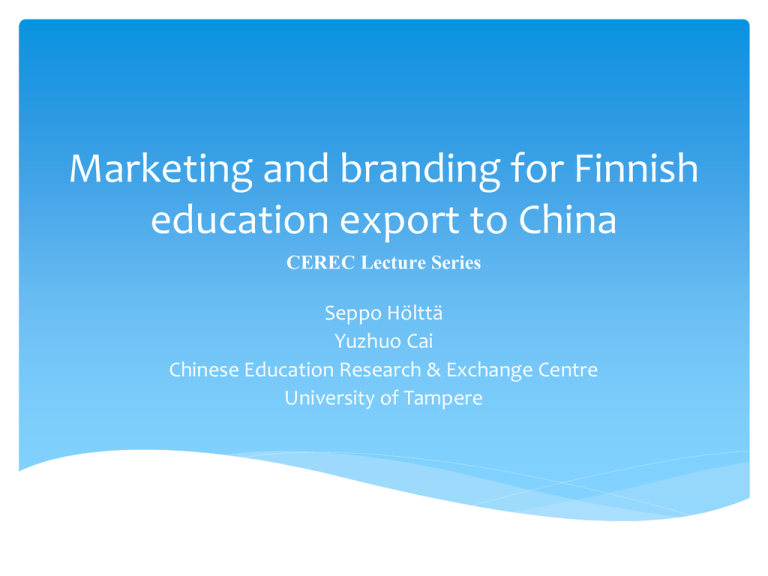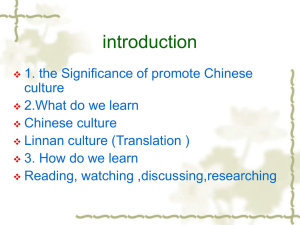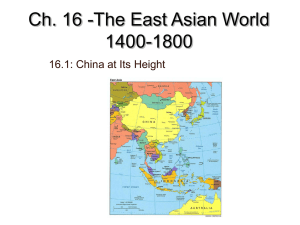Marketing and branding Finnish education in China
advertisement

Marketing and branding for Finnish education export to China CEREC Lecture Series Seppo Hölttä Yuzhuo Cai Chinese Education Research & Exchange Centre University of Tampere Branding, marketing and exporting Branding < marketing < exporting Marketing is an essential step for Finnish education export Branding is a foundational piece in marketing communication 2 Main topics Strategies in marketing Challenges in marketing What is the Chinese market Key approaches/tactics to the Chinese market An example of Higher Education Group (HEG) Experiences from other countires 3 Strategic thinking in marketing & exporting education I We need a systematic and long term commitment, while avoiding one-time deals We need to develop packages of modules We need to develop synergy between education export and industry export instead of each section operating alone We need long term academic capacity building among Finnish HEIs and with top Chinese universities We need to invest in the planning and development of the programmes No failure allowed Importance of Quality Assurance We need a localisation approach rather than standardisation Importance of partnership with Chinese universities 4 Strategic thinking in marketing & exporting education II We need to first strategically build one overarching brand of “Finnish education”, not many brands of institutions and programmes Even together we are a small player in the Chinese markets Need to clarify the roles of Finnish actors (HEIs, companies, Ministries, Finpro/FLF) We need to identify the main Chinese stakeholders and clarify how to operate with them Chinese administration system Chinese culture Benefiting from the successful Finnish brand, individual educational providers can position their niche market and do marketing Need for focused marketing materials and channels Coordination needed 5 Objectives of a good branding Delivers the message clearly Confirms your credibility Connects your target prospects emotionally Motivates the buyer Concretes user loyalty 6 Toward branding understand the needs of your customers integrate your brand strategies at every point of public contact important to invest time in researching, defining, and building your brand 7 Challenges in marketing I Not prepared Do not even think about offering to China a programme which have been prepared for a Finnish student/audience Lacking resources Investment Experiences Experts Not even realise that marketing is necessary and it requires resources We need to understand that we are now living in a global market economy Little commitment to capacity building 8 Importance of research and partnership with Chinese universities Challenges in marketing II Few concrete products to market Risks with products which are not ready for the market place Little knowledge about targeting market Why just Shanghai and Beijing? Importance to identify growing regions/cities and the natures of them Too optimistic to the reality than it is Due to the lack of knowledge and understanding Lack of a brand 9 Chinese market and targeting groups A huge market indeed Chinese young students for degree studies abroad Chinese officials and professionals for training abroad Those particularly interested in Finnish education But hard to catch the business Australian acknowledgement: “the opportunities are there, but the entry costs will be high (Adams, 2007, p. 414). Dutch observation: “Institutional cooperation (in China) is not established overnight …it requires a substantial amount of planning, exchange and commitment” (NESO, 2010, p. 37). 10 Strategies for Different Programmes and Target Groups Degree programmes Professional programmes Taught in Finland Main stakeholders: Students and Parents. Potential Partners: Finnish and European Universities (e.g. Erasmus Mundus), top Chinese Universities. Focus in Marketing: Quality of the Finnish Education system, employability, Safe environment, etc. Main stakeholders: Chinese governmental organisations, universities, professional organisations, commercial training agencies. Potential Partners: Top Chinese Universities and training Institutes, Finnish education institutions, Finnish industry Focus in Marketing: High Technology, Quality of Finnish public services, education system, etc. Taught in China Main stakeholders: Chinese educational authorities, Chinese education institutions, Students and parents. Potential partners: Finnish and Chinese Education institutions Focus in marketing: Quality of Finnish education, employability, etc. Main stakeholders: Chinese educational authorities, Chinese education institutions, Finnish industry Potential partners: Top Chinese Universities and training Institutes, Finnish education institutions, Finnish industry. Focus in Marketing: High Technology, Quality of Finnish public services, education system, etc. 11 Strategies for Different Programmes and Target Groups Taught in Finland Degree programmes Professional programmes Main stakeholders: Students and Parents. Potential Partners: Finnish and European Universities (e.g. Erasmus Mundus), top Chinese Universities. Focus in Marketing: Quality of the Finnish Education system, employability, Safe environment, etc. Main stakeholders: Chinese governmental organisations, universities, professional organisations, commercial training agencies. Potential Partners: Top Chinese Universities and training Institutes, Finnish education institutions, Finnish industry Focus in Marketing: High Technology, Quality of Finnish public services, education system, etc. 12 Strategies for Different Programmes and Target Groups Taught in China Degree programmes Professional programmes Main stakeholders: Chinese educational authorities, Chinese education institutions, Students and parents. Potential partners: Finnish and Chinese Education institutions Focus in marketing: Quality of Finnish education, employability, etc. Main stakeholders: Chinese educational authorities, Chinese education institutions, Finnish industry Potential partners: Top Chinese Universities and training Institutes, Finnish education institutions, Finnish industry. Focus in Marketing: High Technology, Quality of Finnish public services, education system, etc. 13 Chinese customers’ thinking Hierarchical thinking Admire prestige Key influencing factors when choosing the destination for studying abroad Reputation—Ranking Employability development Word of mouth Important role of parents 14 Marketing approaches at the national level I One Finnish brand National coordination National marketing agent Identify the “selling” points or attractiveness of Finnish education Identify key stakeholders and partners in China Provide basic infrastructure for Finnish institutions’ marketing Website/Social media Agents Network Allocate some marketing budget for both national level and institutional level marketing 15 Marketing approaches at the national level II Provide incentives for cooperation between exporters Conduct or support research on understanding the target region Find the fit between Finnish objectives and Chinese needs in internationalisation of education Build a flagship of Finnish education export to China 16 Tactics in marketing to China for individual exporters Understand the targeting regions and the needs in the market Find your products and promote only your best ones Start with the best products with international reputation Rely on all possible partners Alumni Academic community Consulting companies Do marketing and exporting with others 17 Tactics in working with Chinese for individual exporters Be fast and concrete in negotiation Be prepared for disorganised and contingent scheduling Be patient, not in haste with the final deal Respect Chinese clients and partners Show your commitment 18 Solution to the disadvantaged ranking positions (Hed) Partner with prominent Chinese partner institutions Highlight the programmes with international reputation Rely on Finnish industry’s reputation in China Promote advantaged rankings related to higher education/education PISA Innovation Competitiveness 19 Stories of Higher Education Group (HEG) First Erasmus Mundus programme (Marihe) with Chinese degree granting partner (Beijing Normal University) Two times of training for Chinese educational administrators contracted by Chinese MOE Projects with top Chinese universities Support from Chinese stakeholders, including MOE and Embassy 20 “Recipe” of success Capacity building Training expert Academic cooperation Research Networking: Sino-Finland Forum in higher education Investment + entrepreneurial skills Financial investment (academic exchange + research) Training of doctoral students Time beyond work plan Expecting long term return Started targeting China in 2006 Harvesting now but still in the early stage 21 Branding of HEG by partnership with top university Peking University Beijing Normal University Beijing University of Technology by successful stories/ references training programmes for Chinese MOE Erasmus Mundus programme partnering with Beijing Normal by creating CEREC as an interface of Finnish education (not only HEG) to China the first Chinese education centre in Europe appreciated by Chinese government and education institutions a window for Chinese stakeholders to understand Finnish education a gateway to Finnish education 22 What we can learn from our others? Germany as a case Export activities and policies The German University of Cairo , 2003 Export Education in Practice, 2005 “Strategy of the Federal Government for the Internationalization of Science and Research”, MOE 2008 9.4 billion euros in 2009 Agency DAAD (German Academic Exchange Service) iMOVE at the Federal Institute for Vocational Education and Training Key instruments: Financial support Governmental service (training, seminars, coordination, market studies, information system, public database, etc.) Capacity building (training potential talents, academic cooperation) 23 Financial support in Germany DAAD, 4 million project in 2009 Eligible applicants: universities planning to launch a collaborative arrangement, branch campus or off-shore institution in China The programmes undergo a thorough process from feasibility to business planning and funding To receive financial aid, the program has to have proof of success in Germany and show enough potential to achieve further innovation in cooperation with a Chinese university It is also advised for academic and administrative staff to be familiar with societal and educational aspects of the Chinese culture Initial funding is provided for a period of the first cycle of the program – usually 4 years – where the program has to show its selfsustaining character as projected by the business plan. 24 Challenges in Germany Ignorance of differences in society and culture Unrealistically high expectations of what to achieve within a set time frame Sending academic staff with insufficient China experience on a mission often result in conflicts and eventually fatigue on both sides Difficulties for academics to teach aboard when having overloaded regular schedule Project operated by individual professors fizzle out when the main driving individuals retire 25 CEREC’s role Provide knowledge and information Conduct research in the filed Build common image of Finnish education/ marketing interface Networking/coordination Provide business opportunities (connecting Chinese customers to Finnish providers) Facilitate business Consultant or advisor 26 Don’t export to China, if you don’t have your products yet you just want one-time business you are not ready for investing you don’t know Chinese society and culture or have someone with the knowledge to help 27 Concluding words Based commercial based training/education on academic cooperation and cultural programme Do not appear to be too commercial like when exporting education to China We need to build successful stories for marketing Doing business in China=hard work + patience 28








